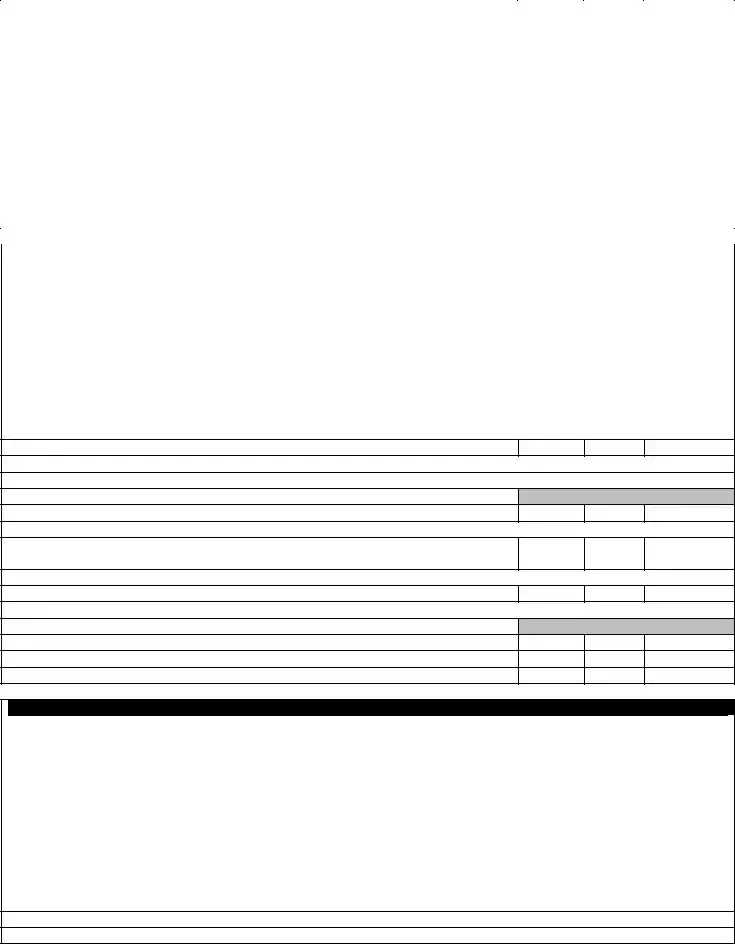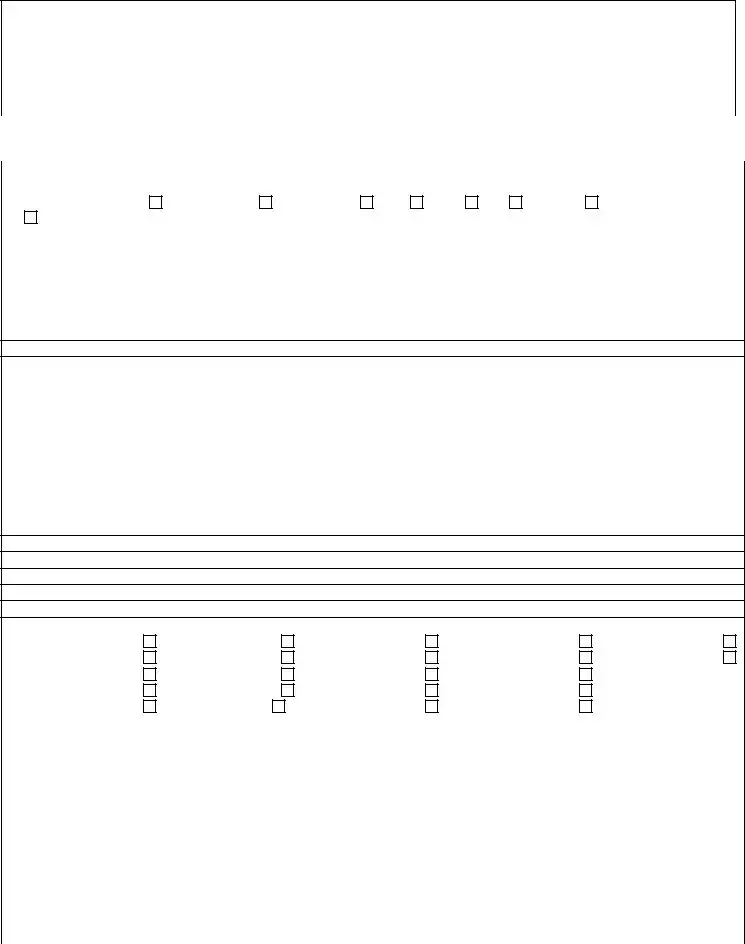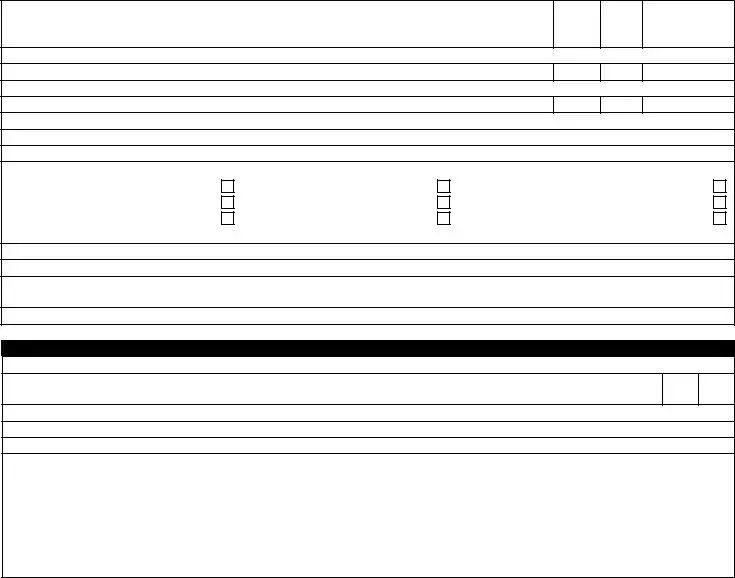RESIDENTIAL PROPERTY DISCLOSURE AND DISCLAIMER STATEMENT
INSTRUCTIONS TO THE SELLER
Please complete the following form. Do not leave any spaces blank. If the question clearly does not apply to the property write "NA". If the answer to any items requires explanation, explain on attached sheets, if necessary.
NOTICE TO THE BUYER
THE FOLLOWING DISCLOSURES ARE MADE BY THE SELLER(S), CONCERNING THE CONDITION OF THE PROPERTY LOCATED AT ______________________________________________________________________________________________
___________________________________________________________________________________________________________.
("THE PROPERTY"), OR AS LEGALLY DESCRIBED ON ATTACHED EXHIBIT A.
DISCLOSURES CONTAINED IN THIS FORM ARE PROVIDED BY THE SELLER ON THE BASIS OF SELLER'S ACTUAL KNOWLEDGE OF THE PROPERTY AT THE TIME THIS DISCLOSURE FORM IS COMPLETED BY THE SELLER. THE FOLLOWING ARE DISCLOSURES MADE BY THE SELLER AND ARE NOT THE REPRESENTATIONS OF ANY REAL ESTATE LICENSEE OR OTHER PARTY. THIS INFORMATION IS FOR DISCLOSURE ONLY AND IS NOT INTENDED TO BE A PART OF ANY WRITTEN AGREEMENT BETWEEN THE BUYER AND THE SELLER.
FOR A MORE COMPREHENSIVE EXAMINATION OF THE SPECIFIC CONDITION OF THIS PROPERTY YOU ARE ADVISED TO OBTAIN AND PAY FOR THE SERVICES OF A QUALIFIED SPECIALIST TO INSPECT THE PROPERTY ON YOUR BEHALF, FOR EXAMPLE, ARCHITECTS, ENGINEERS, LAND SURVEYORS, PLUMBERS, ELECTRICIANS, ROOFERS, BUILDING INSPECTORS, OR PEST AND DRY ROT INSPECTORS. THE PROSPECTIVE BUYER AND THE OWNER MAY WISH TO OBTAIN PROFESSIONAL ADVICE OR INSPECTIONS OF THE PROPERTY AND TO PROVIDE FOR APPROPRIATE PROVISIONS IN A CONTRACT BETWEEN THEM WITH RESPECT TO ANY ADVICE, INSPECTION, DEFECTS OR WARRANTIES.
Seller(s), ____________________________________________________________, [is] / [is not] currently occupying the property.
Seller has owned the property for ______ years.
I. SELLER’S DISCLOSURES. If explanation is needed, use attached sheet if necessary. Approximations should be labeled as such.
A. Do you have legal authority to sell the property?
B. Is title to the property subject to any of the following:
(1) First right of refusal
If yes, explain:
(2) Option
If yes, explain:
(3) Lease or Rental Agreement
If yes, explain:
(4) Life Estate
If yes, explain:
C. Are there any encroachments, boundary disputes, or boundary agreements?
If yes, explain:
D. Are there any rights of way, easements, or access limitations that may affect the owner's use of the property?
If yes, explain:
E. Are there any written agreements for joint maintenance of an easement or right of way?
If yes, explain:
F. Is there any study, survey project, or notice that would adversely affect the property?
If yes, explain:
G. Are there any pending or existing assessments against the property?
If yes, explain:
H. Are there any zoning violations, nonconforming uses, or any unusual restrictions on the subject property that would affect future construction or remodeling?
If yes, explain:
I. Is there a boundary survey for the property? If yes, attach survey.
- 1 -

1. TITLE |
|
|
|
|
YES |
|
|
NO |
UNKNOWN |
J. Are the property’s boundaries marked? |
|
|
|
|
|
|
|
|
|
|
|
If yes, explain: |
|
|
|
|
|
|
|
|
|
|
|
K. Are there fences on the property? |
|
|
|
|
|
|
|
|
|
|
|
If yes, were the fences put up by the property owner? |
|
|
|
|
|
|
|
|
|
|
|
L. Are any trees or other flora on the property diseased, dead or damaged? |
|
|
|
|
|
|
|
|
|
|
|
If yes, explain: |
|
|
|
|
|
|
|
|
|
|
|
M. Are there any covenants, conditions, or restrictions which affect the property? |
|
|
|
|
|
|
|
|
|
If yes, explain: |
|
|
|
|
|
|
|
|
|
|
|
N. Is the property accessed by public or private road? |
|
|
|
PUBLIC |
|
PRIVATE |
|
UNKNOWN |
If private, what yearly upkeep amount is paid by the property owner? |
|
|
|
|
|
|
|
|
|
|
|
If private, explain road upkeep in detail: |
|
|
|
|
|
|
|
|
|
|
|
|
|
|
|
|
|
|
|
|
|
|
|
2. WATER |
|
|
|
|
|
|
|
|
|
|
|
A. Household Water |
|
|
|
|
|
|
|
|
|
|
|
(1) The source of the water is: |
Public |
|
Community |
|
Private |
|
Shared |
(2) Water source information: |
|
|
|
|
YES |
|
|
NO |
UNKNOWN |
a. Are there any written agreements for shared water source? |
|
|
|
|
|
|
|
|
|
|
|
If yes, explain: |
|
|
|
|
|
|
|
|
|
|
|
b. Is there an easement (recorded or unrecorded) for access to and/or maintenance of |
|
|
|
|
|
|
|
|
|
the water source? |
|
|
|
|
|
|
|
|
|
|
|
If yes, explain: |
|
|
|
|
|
|
|
|
|
|
|
c. Are any known problems or repairs needed? |
|
|
|
|
|
|
|
|
|
|
|
If yes, explain: |
|
|
|
|
|
|
|
|
|
|
|
d. Does the source provide an adequate year round supply of potable water? |
|
|
|
|
|
|
|
|
|
e. Are there any water treatment systems (softener, purifier, etc.) for the property?
If yes, explain, and state if the system(s) is/are leased or owned:
B. Irrigation
(1) Are there any water rights for the property?
If yes, explain:
(2)If they exist, to your knowledge, have the water rights been used during the last five- year period?
If yes, explain:
(3) If so, is the certificate available?
Explain:
C. Outdoor Sprinkler System
(1) Is there an outdoor sprinkler system for the property?
(2) Are there any defects in the outdoor sprinkler system?
If yes, explain:
 3. SEWER/SEPTIC SYSTEM
3. SEWER/SEPTIC SYSTEM
A. The property is served by (circle one): |
Public Sewer Main |
Septic Tank System |
|
Other Disposal System |
If other, describe: |
|
|
|
|
|
|
B. If the property is served by a public or community sewer main, is the house connected to the main? |
Yes |
No |
Unknown |
If no, explain: |
|
|
|
|
|
|
C. Is the property currently subject to a sewer capacity charge? |
|
|
Yes |
No |
Unknown |
If yes, explain: |
|
|
|
|
|
|
D. If the property is connected to a septic system: |
|
|
|
|
|
|
(1) Was a permit issued for its construction, and was it approved by the city or county following its |
Yes |
No |
Unknown |
construction? |
|
|
|
|
|
|
(2) On what date was it last pumped: |
|
|
|
|
|
|
(3) Are there any defects in the operation of the septic system? |
|
Yes |
No |
Unknown |
If yes, explain: |
|
|
|
|
|
|
(4) On what date was it last inspected:
By whom:
- 2 -

(5) How many bedrooms was the system approved for?
|
E. Do all plumbing fixtures, including laundry drain, go to the septic/sewer system? |
|
Yes |
No |
|
Unknown |
|
|
If no, explain: |
|
|
|
|
|
|
|
|
F. Are you aware of any changes or repairs to the septic system? |
|
Yes |
No |
|
Unknown |
|
|
If yes, explain: |
|
|
|
|
|
|
|
|
G. Is the septic system, including drainage field, located entirely within the property’s boundaries? |
|
Yes |
No |
|
Unknown |
|
|
If no, explain: |
|
|
|
|
|
|
|
|
|
|
|
|
|
|
|
|
|
4. STRUCTURAL |
|
|
|
|
|
|
|
|
|
|
|
|
|
|
|
|
|
|
A. How old is the current roof? ____ years. (If unknown, mark Unknown.) |
|
|
|
|
|
Unknown |
|
|
Roof is constructed of: Asphalt Shingle, Wood Shingle, Slate, Metal, Tile, Asbestos, |
|
Unknown, |
|
|
|
Other: |
|
|
|
|
|
|
|
|
B. Has the roof leaked during your ownership? |
|
Yes |
No |
Unknown |
|
|
If yes, has it been repaired? |
|
Yes |
No |
|
|
|
Explain any roof repairs of which you are aware: |
|
|
|
|
|
|
|
|
C. Has the house undergone any conversions, additions, or remodeling? |
|
Yes |
No |
Unknown |
|
|
1. If yes, were all building permits obtained? |
|
Yes |
No |
Unknown |
|
|
2. If yes, were all final inspections obtained? |
|
Yes |
No |
Unknown |
|
Explain any conversions/additions/remodeling:
D. Do you know the age of the house? |
Yes |
No |
If yes, give year of original construction (if approximation, indicate such): |
|
|
E. Are you aware of: |
Yes |
No |
(1) |
Any movement, shifting, deterioration or other problems with walls, foundation, crawl space or slab? |
Yes |
No |
(2) |
Any cracks or flaws in the walls, ceilings, foundations, concrete slab, crawl space, basement, floors or garage? |
Yes |
No |
(3) |
Any water leakage or dampness in the crawl space or basement? |
Yes |
No |
(4) |
Any dry rot on the property? |
Yes |
No |
(5) |
Any repairs or other attempts to control the cause or effect of any problem described above? |
Yes |
No |
Explain any ‘Yes’ answer(s) to 1-5 above. When describing repairs or control efforts, describe the location, extent, date, and name of person/company who did the work. Attach any reports and/or other documentation:
F. If you know of any defect(s) regarding the following items, mark the defective item with a check:
1. Foundation |
6. Fire Alarm |
11. Slab Floors |
|
16. Sidewalks |
21. Balconies |
2. Deck |
7. Doors |
12. Driveways |
|
17. Outbuildings |
22. Wood Stoves |
3. Exterior walls |
8. Door locks |
13. Attic Stairs |
|
18. Fireplaces |
|
|
4. Chimneys |
9. Patio |
14. Windows |
|
19. Garage Floors |
|
|
5. Interior walls |
10. Ceilings |
15. Window locks |
|
20. Walkways |
|
|
If you checked any of the above items, explain the defect(s): |
|
|
|
|
|
|
|
|
|
|
|
|
|
|
|
|
|
|
|
|
|
|
|
|
G. In the last 4 years, was a pest, dry rot, structural or "whole house" inspection done? |
|
Yes |
No |
Unknown |
|
|
|
|
If yes, which test(s), when, and by whom was the inspection done? (Attach documentation) |
|
|
|
|
|
|
|
|
|
|
|
|
H. Has the property had a problem with pest control, infestations, or vermin? |
|
Yes |
No |
Unknown |
|
|
|
|
|
|
|
|
If yes, explain: |
|
|
|
|
|
|
|
|
|
|
|
|
|
|
|
I. Are you aware of: |
|
|
|
|
|
|
|
|
|
|
|
|
(1) Any termites, wood destroying insects or pests on or affecting the property? |
|
Yes |
No |
|
|
|
|
|
|
(2) Property damage by termites, wood destroying insects or pests? |
|
Yes |
No |
|
|
|
|
|
|
|
|
|

C. Are there any pending special assessments? |
Yes |
No |
Unknown |
|
|
|
|
D. Are there any shared “common areas” or any joint maintenance agreements (facilities such |
Yes |
No |
Unknown |
as walls, fences, landscaping, pools, tennis courts, walkways, or other areas co-owned in |
|
|
|
undivided interest with others)? |
|
|
|
If any such areas exist, explain: |
|
|
|
|
|
|
|
|
|
|
|
 7. APPLIANCES, HEATING, PLUMBING, ELECTRICAL and OTHER MECHANICAL SYSTEMS
7. APPLIANCES, HEATING, PLUMBING, ELECTRICAL and OTHER MECHANICAL SYSTEMS
Instructions: Mark INCL if the item is included in the sale. If item is included in sale, mark Yes or No to indicate whether item is in working order. Indicate the item’s approximate age (in years) in the ‘age’ space, if provided-- if age is unknown, mark ‘?’ in space.
|
ITEM |
|
|
|
INCL |
|
|
Yes |
|
|
No |
|
|
|
|
ITEM |
|
|
|
INCL |
|
|
Yes |
|
|
No |
|
|
Attic Fan |
|
|
|
|
|
|
|
|
|
|
|
|
|
|
Lawn Sprinkler Auto-timer |
|
|
|
|
|
|
|
|
|
|
|
|
Air Conditioner (central) |
age: |
|
|
|
|
|
|
|
|
|
|
|
|
|
Lawn Sprinkler Backflow Valve |
|
|
|
|
|
Air Conditioner (wall/window) age: |
|
|
|
|
|
|
|
|
|
|
|
|
|
Microwave Oven |
age: |
|
|
|
|
|
|
|
|
|
|
|
|
|
|
|
|
|
|
|
|
|
|
|
|
|
|
|
|
|
|
|
|
|
Air Cleaner/Purifier |
age: |
|
|
|
|
|
|
|
|
|
|
|
|
|
Plumbing |
|
|
|
|
|
|
|
|
|
|
|
|
Ceiling Fan(s), # included ____ |
|
|
|
|
|
|
|
|
|
|
|
|
|
Pool |
age: |
|
|
|
|
|
Clothes Washer |
age: |
|
|
|
|
|
|
|
|
|
|
|
|
|
Pool Equipment/ mechanisms |
age: |
|
|
|
|
|
|
|
|
|
|
|
|
|
|
|
|
|
|
|
|
|
|
|
|
|
|
|
|
|
|
|
|
|
Convection Oven |
age: |
|
|
|
|
|
|
|
|
|
|
|
|
|
Range/Oven |
age: |
|
|
|
|
|
Dishwasher |
age: |
|
|
|
|
|
|
|
|
|
|
|
|
|
Range Timer |
|
|
|
|
|
|
|
|
|
|
|
|
Door Bells |
|
|
|
|
|
|
|
|
|
|
|
|
|
|
Range Vent-hood |
|
|
|
|
|
|
|
|
|
|
|
|
|
|
|
|
|
|
|
|
|
|
|
|
|
|
|
|
|
|
|
|
|
|
|
|
|
|
|
|
Drain Tile System |
|
|
|
|
|
|
|
|
|
|
|
|
|
|
Refrigerator |
age: |
|
|
|
|
|
Dryer |
age: |
|
|
|
|
|
|
|
|
|
|
|
|
|
Security System |
|
|
|
|
|
|
|
|
|
|
|
|
Exhaust Fans (bathroom) |
|
|
|
|
|
|
|
|
|
|
|
|
|
|
Smoke Detectors (battery) |
|
|
|
|
|
|
|
|
|
|
|
|
|
|
|
|
|
|
|
|
|
|
|
|
|
|
|
|
|
|
|
|
|
|
|
|
|
|
|
|
Fireplace |
|
|
|
|
|
|
|
|
|
|
|
|
|
|
Smoke Detectors (hardwired) |
|
|
|
|
|
|
|
|
|
|
|
|
Fireplace Mechanisms |
|
|
|
|
|
|
|
|
|
|
|
|
|
|
Solar Collectors |
|
|
|
|
|
|
|
|
|
|
|
|
Furnace |
age: |
|
|
|
|
|
|
|
|
|
|
|
|
|
Sump Pump |
|
|
|
|
|
|
|
|
|
|
|
|
|
|
|
|
|
|
|
|
|
|
|
|
|
|
|
|
|
|
|
|
|
|
|
|
|
|
|
|
Furnace Mechanisms |
|
|
|
|
|
|
|
|
|
|
|
|
|
|
Toilet Mechanisms |
|
|
|
|
|
|
|
|
|
|
|
|
Freezer |
age: |
|
|
|
|
|
|
|
|
|
|
|
|
|
TV Antenna/ receiver/ dish |
|
|
|
|
|
|
|
|
|
|
|
|
Garbage Compactor |
|
|
|
|
|
|
|
|
|
|
|
|
|
|
TV Cable wiring |
|
|
|
|
|
|
|
|
|
|
|
|
|
|
|
|
|
|
|
|
|
|
|
|
|
|
|
|
|
|
|
|
|
|
|
|
|
|
|
|
Garbage Disposal |
|
|
|
|
|
|
|
|
|
|
|
|
|
|
Water Heater |
age: |
|
|
|
|
|
Garage Door Opener (GDO) |
|
|
|
|
|
|
|
|
|
|
|
|
|
|
Window Treatments |
|
|
|
|
|
|
|
|
|
|
|
|
GDO Auto-reverse Safety Mechanism |
|
|
|
|
|
|
|
|
|
|
|
|
|
Whirlpool/Hot-tub |
age: |
|
|
|
|
|
|
|
|
|
|
|
|
|
|
|
|
|
|
|
|
|
|
|
|
|
|
|
|
|
|
|
|
|
GDO Remote Opener(s), # included: ___ |
|
|
|
|
|
|
|
|
|
|
|
|
|
Wood Burning Stove |
|
|
|
|
|
|
|
|
|
|
|
|
Gas Grill |
|
|
|
|
|
|
|
|
|
|
|
|
|
|
Yard Lights |
|
|
|
|
|
|
|
|
|
|
|
|
Gas Logs |
|
|
|
|
|
|
|
|
|
|
|
|
|
|
Other: |
|
|
|
|
|
|
|
|
|
|
|
|
|
|
|
|
|
|
|
|
|
|
|
|
|
|
|
|
|
|
|
|
|
|
|
|
|
|
|
|
Heating System (central) |
age: |
|
|
|
|
|
|
|
|
|
|
|
|
|
Other: |
|
|
|
|
|
|
|
|
|
|
|
|
Heating System (supplemental) age: |
|
|
|
|
|
|
|
|
|
|
|
|
|
Other: |
|
|
|
|
|
|
|
|
|
|
|
|
Humidifier |
age: |
|
|
|
|
|
|
|
|
|
|
|
|
|
Other: |
|
|
|
|
|
|
|
|
|
|
|
|
|
|
|
|
|
|
|
|
|
|
|
|
|
|
|
|
|
|
|
|
|
|
|
|
|
|
|
|
Incinerator |
|
|
|
|
|
|
|
|
|
|
|
|
|
|
Other: |
|
|
|
|
|
|
|
|
|
|
|
|
Intercom |
|
|
|
|
|
|
|
|
|
|
|
|
|
|
Other: |
|
|
|
|
|
|
|
|
|
|
|
|
Lawn Sprinkler System |
|
|
|
|
|
|
|
|
|
|
|
|
|
|
Other: |
|
|
|
|
|
|
|
|
|
|
|
|
|
|
|
|
|
|
|
|
|
|
|
|
|
|
|
|
|
|
|
|
|
|
|
|
|
|
|
Explanations: if any item above is NOT in working order, list the item and explain the defect in the space below.
8. GENERAL |
|
YES |
|
NO |
UNKNOWN |
A. Is there any settling, soil, standing water, or drainage problems on the property?
If yes, explain:
B. Does the property contain fill material?
C. Is there any material damage to the property or any of the structure from fire, wind, floods, beach movements, earthquake, expansive soils, or landslides?
If yes, explain:
D. Is the property in a designated flood plain?

E. Are there any substances, materials, or products that may be an environmental hazard such as, but not limited to, asbestos, formaldehyde, radon gas, lead-based paint, fuel or chemical storage tanks and contaminated soil or water on the subject property?
If yes, explain:
F. Are there any tanks or underground storage tanks (e.g., chemical, fuel, etc.) on the property?
If yes, explain, and give approx. position (attach map):
G. Has the property ever been used as an illegal drug-manufacturing site?
If yes, explain:
H. If the property contains a wood-burning stove or fireplace, when was/were the chimney(ies) last cleaned?
Detail date(s) and chimney(ies), or mark Unknown:
I. Are you aware of any of the following regarding the property?
Existing or threatened legal action |
Violation of any law or regulation |
General stains or pet stains to carpet or floor |
Transferable warranties |
Any locks without keys |
Unrecorded interests affecting the property |
Fire Damage at any time |
Appraiser or Mechanic’s Lien |
Landfills or underground problems |
If any of the above are marked, explain: |
|
|
J.If any tests to detect radon gas have been done on the property, provide documentation. If radon gas has been detected on the property, explain when, where, by whom, and all other details:
9.FULL DISCLOSURE BY SELLERS
A. Other conditions or defects:
Does the Seller know of any other material defects affecting this property or its value that a prospective buyer |
Yes No |
should know about?
If yes, explain:
B. Verification:
The foregoing answers and attached explanations (if any) are complete and correct to the best of my/our knowledge and I/we have received a copy hereof. I/we authorize all of my/our real estate licensees, if any, to deliver a copy of this disclosure statement to other real estate licensees and all prospective buyers of the property.
____________________________ _____________________________________ _____________________________________
II. BUYER'S ACKNOWLEDGMENT
A.As buyer(s), I/we acknowledge the duty to pay diligent attention to any material defects which are known to me/us or can be known to me/us by utilizing diligent attention and observation.
B.Each buyer acknowledges and understands that the disclosures set forth in this statement and in any amendments to this statement are made only by the seller.
C.Buyer (which term includes all persons signing the buyer's acknowledgement portion of this disclosure statement below) hereby acknowledges receipt of a copy of this disclosure statement (including attachments, if any) bearing seller's signature.
DISCLOSURES CONTAINED IN THIS FORM ARE PROVIDED BY THE SELLER ON THE BASIS OF SELLER'S ACTUAL KNOWLEDGE OF THE PROPERTY AT THE TIME OF DISCLOSURE.
BUYER HEREBY ACKNOWLEDGES RECEIPT OF A COPY OF THIS REAL PROPERTY TRANSFER DISCLOSURE STATEMENT AND ACKNOWLEDGES THAT THE DISCLOSURES MADE HEREIN ARE THOSE OF THE SELLER ONLY, AND NOT OF ANY REAL ESTATE LICENSEE OR OTHER PARTY.
___________________________ |
______________________________ |
_____________________________ |
DATE |
BUYER |
BUYER |


 3. SEWER/SEPTIC SYSTEM
3. SEWER/SEPTIC SYSTEM


 7. APPLIANCES, HEATING, PLUMBING, ELECTRICAL and OTHER MECHANICAL SYSTEMS
7. APPLIANCES, HEATING, PLUMBING, ELECTRICAL and OTHER MECHANICAL SYSTEMS